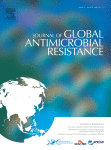Ver ítem
- xmlui.general.dspace_homeCentros e Institutos de InvestigaciónCICVyA. Centro de Investigación en Ciencias Veterinarias y AgronómicasInstituto de GenéticaArtículos científicosxmlui.ArtifactBrowser.ItemViewer.trail
- Inicio
- Centros e Institutos de Investigación
- CICVyA. Centro de Investigación en Ciencias Veterinarias y Agronómicas
- Instituto de Genética
- Artículos científicos
- Ver ítem
Synthetic multi-antibiotic resistant plasmids in plant-associated bacteria from agricultural soils
Resumen
Objectives: Unlike higher organisms such as domestic animals and cultivated plants, which display a robust reproductive isolation and limited dispersal ability, microbes exhibit an extremely promiscuous gene flow and can rapidly disperse across the planet by multiple ways. Thus, microbial plasmids, including synthetic replicons, containing antibiotic resistance genes are a serious risk to public health. In this short communication, we explored the
[ver mas...]
Objectives: Unlike higher organisms such as domestic animals and cultivated plants, which display a robust reproductive isolation and limited dispersal ability, microbes exhibit an extremely promiscuous gene flow and can rapidly disperse across the planet by multiple ways. Thus, microbial plasmids, including synthetic replicons, containing antibiotic resistance genes are a serious risk to public health. In this short communication, we explored the presence of synthetic elements in alfalfa symbionts (Ensifer meliloti strains) from agricultural soils.
Methods: A total of 148 E. meliloti isolates from alfalfa plants growing under field conditions were collected from January 2015 to June 2019. Antimicrobial susceptibility testing was performed under laboratory conditions. We identified five kanamycin-resistant E. meliloti strains (named K1-K5). Whole genome sequencing analysis and conjugations were used to identify and study the plasmids of K strains.
Results: We found that the genomes of K strains contain ampicillin, kanamycin and tetracycline resistance genes, the reporter gene lacZ from Escherichia coli and multiple cloning sites. These sequences were found within <58-kb plasmids related to the self-transmissible IncP plasmid RP4 from human pathogen Pseudomonas aeruginosa. Conjugation experiments confirmed the ability of K strains to transfer antibiotic resistance via conjugation to the Pseudomonas background.
Conclusion: In addition to the traditional analysis of plant growth-promoting factors, the commercial deregulation of putative natural inoculants should also include genomic studies to ensure a reasonable balance between innovation and caution.
[Cerrar]

Autor
Fuente
Journal of Global Antimicrobial Resistance 22 : 113-116 (Septiembre 2020)
Fecha
2020-09
Editorial
Elsevier
ISSN
2213-7173
Formato
pdf
Tipo de documento
artículo
Palabras Claves
Derechos de acceso
Abierto
 Excepto donde se diga explicitamente, este item se publica bajo la siguiente descripción: Creative Commons Attribution-NonCommercial-ShareAlike 2.5 Unported (CC BY-NC-SA 2.5)
Excepto donde se diga explicitamente, este item se publica bajo la siguiente descripción: Creative Commons Attribution-NonCommercial-ShareAlike 2.5 Unported (CC BY-NC-SA 2.5)


